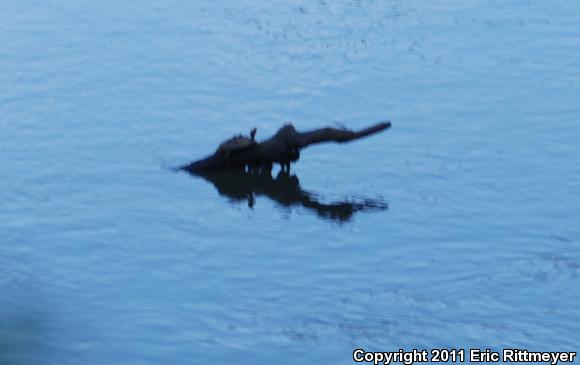Ringed Map Turtle (Graptemys oculifera)
Created: November 15th, 2011 - 08:48 PM
Last Modified: November 15th, 2011 - 08:50 PM Entered by: Eric Rittmeyer
Record 96185
Last Modified: November 15th, 2011 - 08:50 PM Entered by: Eric Rittmeyer
Record 96185
|
Country: United States |
State: Louisiana |
County: Washington Parish |
Time: 2011-11-15 00:00:00 |
|
|
Qty: 1 |
Age: Adult |
Sex: Male |
Method: Visual encounter |
Habitat: ----- |
|
Body Temperature: ----- |
Air Temperature: ----- |
Ground Temperature: ----- |
Humidity: ----- |
|
|
Sky Conditions: ----- |
Moon Phase: ----- |
Elevation: ----- |
Barometric Pressure: ----- |
|
Notes
Apologies for the poor quality voucher photo, the turtle was basking some distance away, and this was the only photo I got before it dove. However, the characteristic yellow rings on the carapace were clearly visible through binoculars.
Vouchers



Comments
Yeah, the colors are definitely correct on my copy. Of course I had to replace my copy around 2006 or so, so it's probably a later printing with the error corrected. Interesting.
I have the 1998 edition and it's wrong in mine...look at yours again and check the colors on the little map...of course,yours may be a different printing where they corrected the error...
No worries, Brian. Just out of curiousity, which version of Conant & Collins do you have? My 1998 copy has it colored correctly. But yeah, a mistake like mixing up a couple colors on the map would be easy to do, easy to miss, and could certainly confuse a lot of people. One of these days I'm going to head further east in search of some of the other Graptemys, but I've now found all the Louisiana and New York species, so it's a start.
LOL...Collins has the map colored wrong in the field guide, but the text is correct. You are correct, but I bet that goof in the field guide confuses a lot of people...sorry about that.
Brian, I think you're confusing the distribution of G. oculifera with another species of Graptemys. Graptemys oculifera is endemic to the Pearl River drainage on the border of Mississippi and Louisiana (and does not occur in Alabama). The species has also previously been collected from this locality.
This species is only found in Alabama and Mississippi. Are you sure of the I.D.?